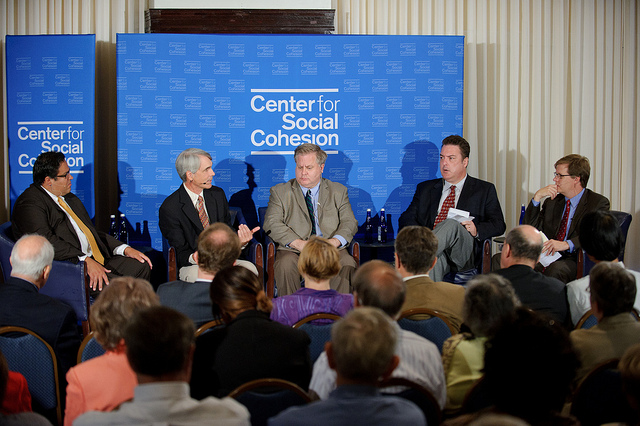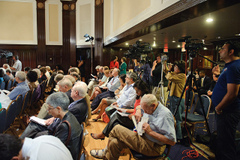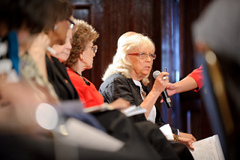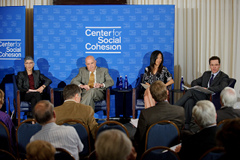
Retired Supreme Court Justice Sandra Day O’Connor opened a conference on social cohesion in the United States by offering up the method of bringing people together she used as majority leader of the Arizona State Senate in the 1970s.
After work, she said, “I’d get everybody together and cook Mexican food, and we’d sit around outside and eat Mexican food and drink beer and make friends with each other. That worked.” So, the question, she continued, is “how can we as a nation sit around and eat Mexican food and drink beer and make friends?”
The question served as a running theme for “Can the United States Remain United?,” a half-day conference curated by the Center for Social Cohesion, a joint project of Arizona State University and Zócalo Public Square in partnership with the New America Foundation. More than 100 people crowded a lecture hall at the National Press Club in downtown Washington to hear O’Connor, Harvard law professor Randall Kennedy and two panels of experts on the forces that divide and unite Americans today.
Read remarks from O’Connor and Kennedy.
Framing the Conversation
The first panel of the event, “What’s Dividing Us?” (pictured at top), began by setting the parameters of the discussion. Gregory Rodriguez, founder of the Center for Social Cohesion, said he focused for many years on immigration issues, studying how new immigrants become part of “the whole.” More recently, he’s taken a step back, asking “What is the whole?” That question, he said, helped lead to the creation of the Center for Social Cohesion and guided the conference in Washington.
 One topic of debate was whether social cohesion is a bigger problem in the United States today than it has been historically – in other words, are we more divided than ever before? Participants on the first panel, moderated by Center for Social Cohesion fellow and New America Foundation fellowship director Andrés Martinez, brought varying opinions.
One topic of debate was whether social cohesion is a bigger problem in the United States today than it has been historically – in other words, are we more divided than ever before? Participants on the first panel, moderated by Center for Social Cohesion fellow and New America Foundation fellowship director Andrés Martinez, brought varying opinions.
James Gimpel, a political scientist at the University of Maryland who co-wrote Our Patchwork Nation: The Surprising Truth About the “Real” America, said there is less cohesion today than in the past. Political divisions, he said, once were simply stand-ins for people’s socioeconomic status. Now, he said, partisanship has come to represent all sorts of other differences between Americans.
“It seems like in the ‘60s and ‘70s, the economic foundation of the party system remained there, but overlaid on top of that came these cultural issues and divisions,” he said. Now, “your music preferences predict your political identity.”
But Michael Lind, co-director of the Economic Growth Program and the Next Social Contract Initiative at the New America Foundation, took issue with the claim that Americans are more divided today.
“At the political level we’re more divided,” he said, acknowledging partisan rancor in Washington. “At a social level, I think we’re more integrated, outside of immigrant enclaves, than we’ve ever been.”
In the keynote address, Kennedy identified poverty as America’s deepest fault line. Poor people in America, he said, don’t have the chance to participate fully in society because their circumstances hold them down.
Diagnosing Demographics
 Journalist Bill Bishop, author of The Big Sort: Why the Clustering of Like-Minded America is Tearing Us Apart, agreed with Gimpel and said the trend away from interacting with people different from themselves might seem counterintuitive in a nation that has steadily become more diverse.
Journalist Bill Bishop, author of The Big Sort: Why the Clustering of Like-Minded America is Tearing Us Apart, agreed with Gimpel and said the trend away from interacting with people different from themselves might seem counterintuitive in a nation that has steadily become more diverse.
“Essentially, what we’re seeing is this weird event where where we live is becoming more homogenous, but from place to place within the United States, we’re seeing greater diversity,” he said.
Bishop mentioned a handful of examples of that paradox from his book. Income differences between towns have risen, and the number of people with college degrees has skyrocketed in some places – like Bishop’s hometown of Austin, Tex., Los Angeles and the nation’s capital, to name a few – while plummeting in many others. And, of course, the number of counties in which elections are decided by 20 or more points – whether in favor of Republican or Democrat candidates – has increased dramatically. In short, he said, Americans are sorting themselves into tribes of people like them.
Gimpel’s book and corresponding web site uses a similar framework to Bishop’s. He has divided the nation into 12 types of counties – from “Mormon Outposts” to “Industrial Metropolises” to “Monied ‘burbs” and “Tractor Country” – that divide people based on their lifestyle and priorities rather than geography.
Martinez, the former editorial page editor of the Los Angeles Times , said that this type of clustering made his job very difficult.
“People think that when an editorial takes a side of an issue, they should be able to infer where you’ll come down on every other issue,” he said. “So even for people who try to set themselves up as arbiters from the sideline who decide each issue separately, people get very angry and confused if you start mixing and matching and trying to plot an independent course.”
New Americans Joining the Fold
 The second panel, titled “What Are We Loyal To?”, focused primarily on how immigration has affected the ways both native- and foreign-born Americans cohere.
The second panel, titled “What Are We Loyal To?”, focused primarily on how immigration has affected the ways both native- and foreign-born Americans cohere.
Tamar Jacoby, a journalist and CEO of ImmigrationWorks USA, a national federation of small business owners working for better immigration laws, framed the conversation with some dramatic statistics. In 1970, following decades of extremely tight restrictions on immigration to the United States, five percent of American residents were foreign-born. Today, 13 percent of Americans were born in other countries.
Luis Lugo, director of the Pew Research Center’s Forum on Religion and Public Life and a Cuban immigrant, said new Americans’ religious affiliations often dictate what level of cohesion they find in the United States. Latino immigrants, who are generally Christian, often have an easier time finding a religious home than Muslims or Hindus from the Middle East and South Asia, he said.
University of California at Irvine sociologist Jennifer Lee said immigrants’ social cohesion patterns are poorly understood. For example, the idea that immigrants are not learning English is a misconception, she said, concluding that “children of immigrants uniformly speak English well or very well.”
Furthermore, she said, interracial relationships are increasingly common, a key indicator of cohesion. In 2008, one of every seven marriages was between people of different races or ethnicities.
Increased diversity, Lee said, is “actually not leading to fragmentation, but a reduction of social divisions among groups.”
In fact, Jacoby said, immigrants are often the people most interested in cohering to American society, and Rodriguez added during his panel that white Americans are increasingly the people feeling aggrieved.
“Often, immigrants are coming together around sense of patriotism and a sense that they belong here while the white people in Los Angeles and Kansas are fighting their civil war,” Jacoby said.
For event photos, please click here.
*Photos by Sam Hurd




Send A Letter To the Editors